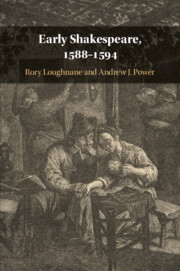Book contents
- Early Shakespeare, 1588–1594
- Early Shakespeare, 1588–1594
- Copyright page
- Contents
- Tables
- Notes on Contributors
- Acknowledgements
- Abbreviations
- Introduction Beginning with Shakespeare
- Chapter 1 Shakespeare and the Idea of Early Authorship
- Chapter 2 Collaboration and Shakespeare’s Early Career
- Chapter 3 The Language and Style of Early Shakespeare
- Chapter 4 Shakespeare’s Early Verse Style
- Chapter 5 Early Shakespeare, Chaucer, and Narrative Theory:
- Chapter 6 Poetry, Counsel, and Coercion in Shakespeare’s Early History Plays
- Chapter 7 John Lyly and Shakespeare’s Early Career
- Chapter 8 Spenser and Shakespeare: Bards of a Feather?
- Chapter 9 Arden of Faversham, Richard Burbage, and the Early Shakespeare Canon
- Chapter 10 Boy Parts in Early Shakespeare
- Chapter 11 The Origins of Richard Duke of York
- Chapter 12 Early Shakespeare and the Authorship of The Taming of the Shrew
- Chapter 13 Who Read What When?
- Book part
- Select Bibliography
- Index
Chapter 3 - The Language and Style of Early Shakespeare
Published online by Cambridge University Press: 17 April 2020
- Early Shakespeare, 1588–1594
- Early Shakespeare, 1588–1594
- Copyright page
- Contents
- Tables
- Notes on Contributors
- Acknowledgements
- Abbreviations
- Introduction Beginning with Shakespeare
- Chapter 1 Shakespeare and the Idea of Early Authorship
- Chapter 2 Collaboration and Shakespeare’s Early Career
- Chapter 3 The Language and Style of Early Shakespeare
- Chapter 4 Shakespeare’s Early Verse Style
- Chapter 5 Early Shakespeare, Chaucer, and Narrative Theory:
- Chapter 6 Poetry, Counsel, and Coercion in Shakespeare’s Early History Plays
- Chapter 7 John Lyly and Shakespeare’s Early Career
- Chapter 8 Spenser and Shakespeare: Bards of a Feather?
- Chapter 9 Arden of Faversham, Richard Burbage, and the Early Shakespeare Canon
- Chapter 10 Boy Parts in Early Shakespeare
- Chapter 11 The Origins of Richard Duke of York
- Chapter 12 Early Shakespeare and the Authorship of The Taming of the Shrew
- Chapter 13 Who Read What When?
- Book part
- Select Bibliography
- Index
Summary
This chapter illuminates the authenticity and variety of the rhetorical styles of writing in a selection of Shakespeare’s earliest plays and the epyllion, Venus and Adonis. Focusing on bombast and repetition as two of the most frequent and representative rhetorical techniques that stand out in Shakespeare’s early writing, and addressing the earliest attack on Shakespeare’s writing craft, the chapter explores different ways in which Shakespeare turns rhetoric into an instrument that produces meaning. Critical attention is paid on examining how Shakespeare produces originality in collaborative and solo works and on radical uses of rhetoric for unrhetorical purpose. Comparing Shakespeare to some of the contemporaries that inspired his writing, like Marlowe, Greene, and Lodge, the chapter offers an insight into forms of imitation and creative resistance to existing models, on examples that have not yet been explored, and within the debate about styles in poetic and rhetorical treatises of the late Elizabethan period.
- Type
- Chapter
- Information
- Early Shakespeare, 1588–1594 , pp. 76 - 101Publisher: Cambridge University PressPrint publication year: 2020
- 1
- Cited by



